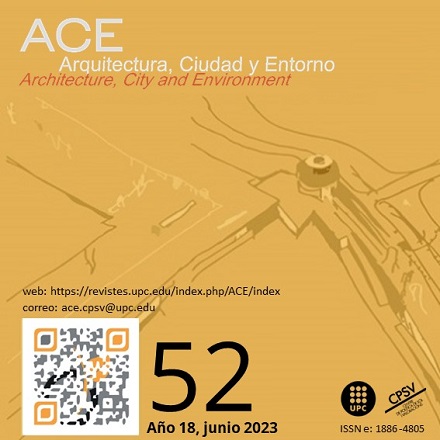Heritage Assessment of the Colegio de San Simón Chapel (1953-1955), in Ibagué, Colombia
DOI:
https://doi.org/10.5821/ace.18.52.11960Keywords:
Cultural heritage, 20th-century heritage, laminar structures, Juvenal MoyaAbstract
Colombia, a tropical country with Atlantic and Pacific coasts, enjoys an outstanding natural and cultural heritage that would be lost if not protected. Said protection is supported by various national laws, including the one corresponding to the BICN (National Cultural Interest Assets). This article aims to demonstrate the values of the chapel of the Colegio de San Simón, in Ibagué, Tolima, in the center of the country. The building's values are analysed here in fundamental aspects of heritage recognition, evident in other cases already recognised as BICN values: natural, cultural, historical, social, landscape, and mainly urban-architectural. Hence, it carries out a historiographical reflection involving the goodness of the design and state of conservation, recognising the impacts and threats to the property. Therefore, the convenience of cataloging it as BICN and advancing the corresponding PEMP (Special Heritage Management Plan) to protect it and guarantee its permanence in the memory of society and ensure the commitment of local authorities to the POT (Territorial Ordering Plan) of the municipality of Ibagué, which should begin its review soon. The chapel is a lesser-known work by Juvenal Moya Cadena (1918-1958), who created notable examples of religious architecture in Colombia, outstanding for its design using a lightened shell or membrane and the use of reinforced ceramic technology in collaboration with engineer Guillermo González Zuleta. The chapel is a lesser-known work by Juvenal Moya Cadena (1918-1958), who created notable examples of religious architecture in Colombia, outstanding for its design using a lightened shell or membrane and the use of reinforced ceramic technology in collaboration with engineer Guillermo González Zuleta. The article also explores the state of the art of design and construction technology in the early 1950s in Latin America, whose adaptation to the tropics was influenced by Le Corbusier contrasting with the conceptual and compositional elements of Óscar Niemeyer and Félix Candela.
Downloads
Published
Issue
Section
License
| INTELECTUAL PROTECTION CRITERIA |
At this moment, it is count with the "Oficina Española de Patentes y Marcas", while global protection it is being processed by the World Intelectual Property Organization (OMPI/WIPO). Nevertheless the International Standard Serial Number Office (ISSN) has given the following numbers ISSN: 1886-4805 (electronic version) and 1887-7052 (paper version). All articles will be peer reviewed, using double blind reviewing. |
| COPYRIGHT |
The article contents and their comments are authors exclusive liability, and do not reflect necessarily the journal editor commitee's opinion. All ACE published works are subject to the following licence CC BY-NC-ND 3.0 ES http://creativecommons.org/licenses/by-nc-nd/3.0/es/ It implies that authors do not hold nor retain the copyright without restrictions but only those included in the licence. |


































